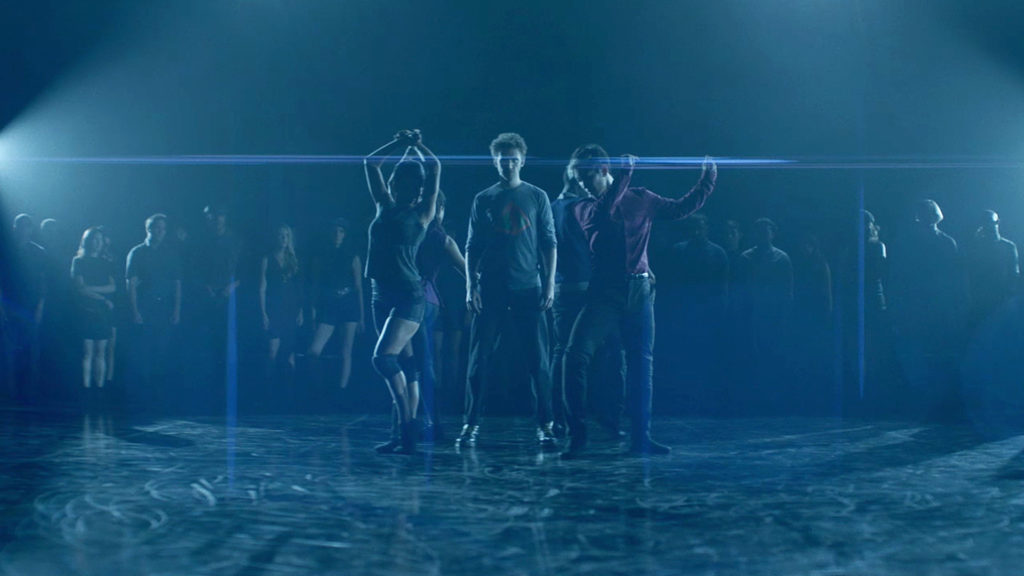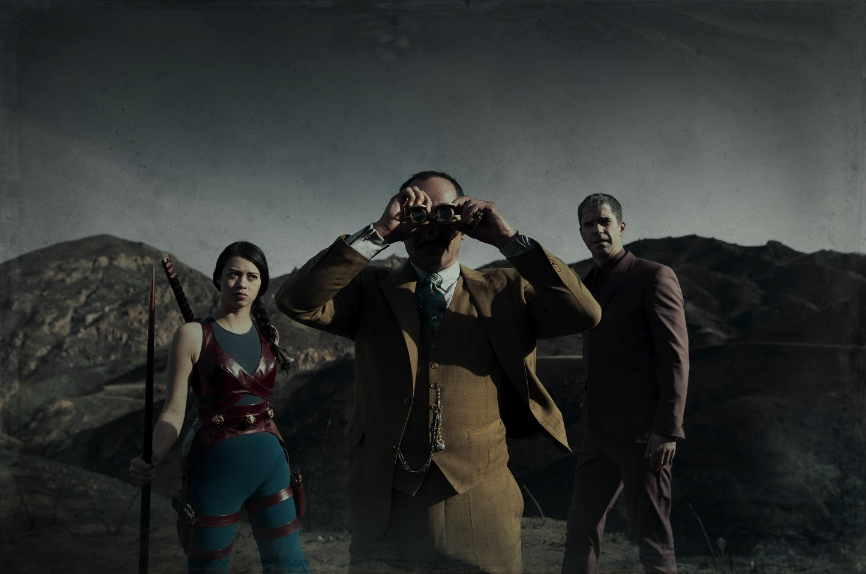
Cassondra Feltus is a St. Louis-based freelance writer best known…
Before Wanda Maximoff created her own alternate reality sitcom-style town of Westview, before Moon Knight’s Steven Grant discovered that he has another personality, Noah Hawley (Fargo) brought us Legion, X-Men’s story of a powerful telepathic antihero who doesn’t know he’s an Omega-level psychic mutant. The 2017 FX series laid the groundwork for all the surreal superhero stories to come, sending audiences on a psychedelic trip exploring the human (and mutant) mind.

Warning: Spoilers for season 1 of Legion.
David Haller (Dan Stevens), is a young man diagnosed with paranoid schizophrenia who’s spent his life with therapists and medications. The pilot opens with a montage of David as a baby through adolescence, leading up to his current state at Clockworks Psychiatric Hospital.
Since we enter the show with David, we’re in his subjective reality, questioning what is actually real and what is a delusion. He’s the ultimate unreliable narrator. Those familiar with the X-Men comics know David as the son of telepath Charles Xavier, aka Professor X. The series changes his backstory a little but keeps Charles as his father, a man who David didn’t know about until adulthood.

While at Clockworks, he hangs out with his pal Lenny “Cornflakes” Busker (Aubrey Plaza), who has a history of substance abuse. She’s a rather optimistic personality, spending her days eating Twizzlers and dancing around with headphones.
David is instantly infatuated with Sydney “Syd” Barrett (Rachel Keller) when she arrives at the hospital. The two quickly begin a relationship but can’t be intimate because Sydney doesn’t like to be touched. And we find out why later in the episode when a kiss makes them temporarily swap bodies.

Sydney, in David’s body and unable to handle his powers, causes an accident at Clockworks, resulting in the death of Lenny, (But don’t worry, she comes back!), and an investigation by Division 3, an anti-mutant government agency. After fleeing D3, David joins his untouchable lover and the rogue mutants of Summerland.

Ptonomy Wallace (Jeremie Harris) is a “memory artist” with the power (or curse) to remember everything, as well as travel inside the memories of others. Kerry Loudermilk (Amber Midthunder) is a skilled fighter and the brawn of scientist Cary Loudermilk’s (Bill Irwin) brains. She lives inside of when she’s not outside engaging in hand-to-hand combat. The Summerland facility’s co-founder, psychiatric therapist Melanie Bird (Jean Smart), wants to help him control his powers.

The world of Legion exists outside of the MCU in its own no-time place, where everyone’s dressed in 60s/70s style clothes but has access to iPad-like technology. Hawley has cited the work of Stanley Kubrick’s A Clockwork Orange and 2001: A Space Odyssey as being highly influential to the series’ overall retro-futuristic aesthetic crafted by production designer Michael Wylie (Tales from the Loop, Agent Carter).
The trippy visual style transports the audience to this strange period-less universe full of jump cuts, disorienting angles, slow-motion sequences, and kaleidoscopic lighting. One episode temporarily turns into a black and white silent film.

For the first season, costume designer Carol Case (Fargo), worked with Hawley to create time, uncanny wardrobes for all the characters. There’s mostly a British mod style to the outfits, especially for the female characters like Sydney and David’s sister Amy (Katie Aselton). David has a British punk vibe with Doc Martens and cuffed pants. Cary, Ptonomy, D3’s Clark Debussy (Hamish Linklater and Amahl Farouk (Navid Negahban) are always dapper in their sharp, stylish suits.

Seasons 2 and 3 had Robert Blackman (Star Trek: The Next Generation) to evolve some of the character’s styles, with David and Lenny, in particular, going full 70s hippie vibe in the third season. The final season also introduces the time-traveling mutant Switch (Lauren Tsai), who has a Harajuku street style.

In a 2016 New York Comic-Con panel, Hawley said that he wanted the show to feel like Pink Floyd’s Dark Side of the Moon because the 1973 album is “really the soundscape of mental illness to some degree.” The character of Syd Barrett is also named after the Pink Floyd band member. Music plays a significant role in the series with artists like The Rolling Stones, The Who, Talking Heads, and of course, Pink Floyd. Thanks to the incredible composer Jeff Russo (The Man Who Fell to Earth, The Umbrella Academy), it’s one of Legion’s many great elements. Russo’s score mixes electronic and orchestra sounds with lots of ambient tracks and horror film-type notes, which closed captioning calls “harsh wailing.”

Dancing is used to tell parts of the story, usually letting us know that this is a dream sequence. In the first episode, David dreams about Sydney and other Clockworks patients performing a Bollywood-style dance number to Serge Gainsbourg’s “Pauvre Lola.” Plaza’s Lenny takes a moment from mentally playing with David and his Summerland friends to enjoy a cabaret-esque dance to the Bassnectar remix of Nina Simone’s “Feeling Good.”

Hawley also forgoes the traditional superhero fight sequences. In an FX the scenes featurette, he said, “I don’t find action for its own sake to be very interesting. So, how do you show conflict between characters in a way that feels fresh or interesting?” The answer: a dance battle. Flight of the Conchords’ Jemaine Clement, who plays Melanie’s husband, another psychic mutant stuck in the astral plane, has both a dance battle and rap battle.

Legion is a character-driven story with mutants and humans alike. We’re with David most of the time, inside his tainted mind that’s constantly deciphering what is reality. Lenny is by far my favorite character, played by the brilliant Aubrey Plaza. The actress drew inspiration from figures like David Bowie and Beetlejuice to create a gleeful villain that switches from cunning to crazed. She appears to David, which he accepts as one of his many delusions.

About halfway through the first season, David discovers he’s been haunted by the Shadow King, a psychic mutant villain who infected his mind as a baby. The parasitic entity has worn many faces, including Lenny and David’s childhood dog, aptly named King. It isn’t until the second season that we meet the Shadow King’s true form, Amahl Farouk (Navid Negahban). I won’t spoil the rest of what goes down between them, but I’ll say it’s not your typical hero vs villain fight.

Like other X-Men projects, Legion revolves around themes of otherness, intolerance, and self-identity. The characters in this series are very human and have non-superhero ways of dealing with their otherworldly problems, like being in a mental institution and using drugs. David’s mental health is at the forefront, beginning as a vulnerable man who spent his life being told he had schizophrenia when he’s actually a god-like being possessing superpowers. But as the seasons go on, they explore how his inherited powers are affected by his mental illness, and vice versa.

Comic book characters and storylines are often weird — superpowered beings, magic, other dimensions, aliens, time travel, alternate realities. But not all comic book shows and movies are weird. How else would the stories of Wanda Maximoff, Loki, or Steven Grant/Marc Spector be told if not for some bizarre, cerebral storytelling elements? It would be impossible to create a live-action Doom Patrol or Gotham without some seriously strange characters, visuals, and plot lines. Legion is truly a masterpiece that broke ground in the genre, giving creators permission to embrace the surreal.
All three seasons of Legion are available to stream now on Hulu.
Cassondra Feltus is a St. Louis-based freelance writer best known for film, television, and pop culture analysis which has appeared on Black Girl Nerds, WatchMojo, and The Take. She loves naps, Paul Rudd, and binge-watching the latest series with her two gorgeous pups – Harry and DeVito.









